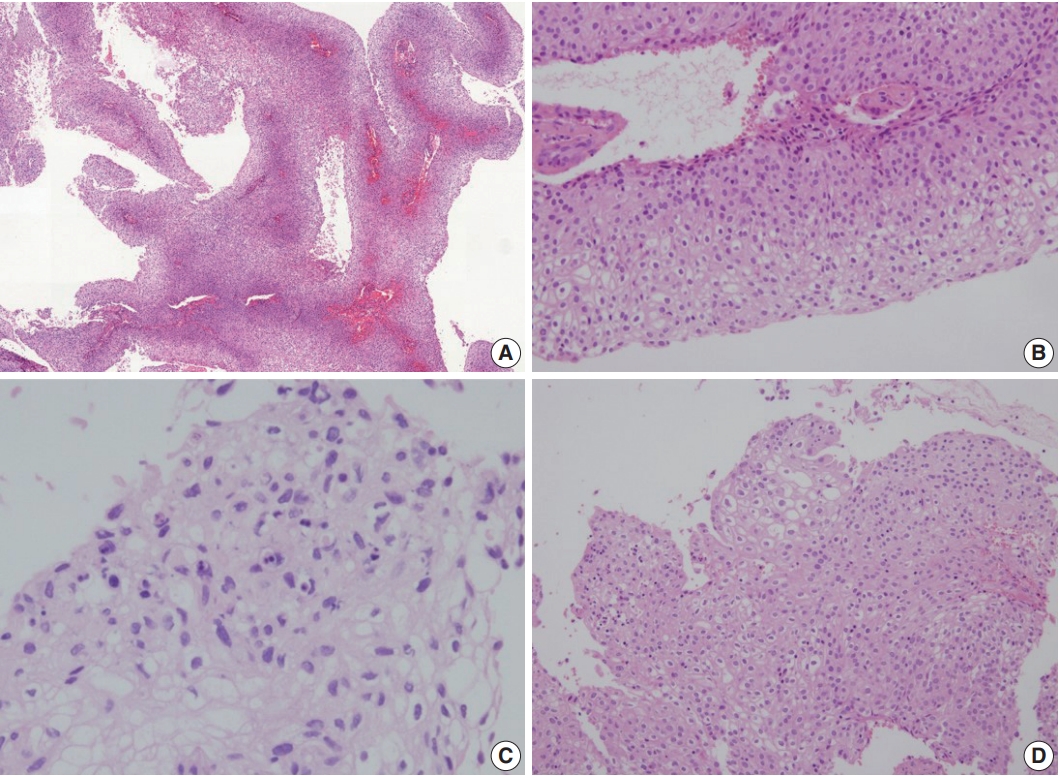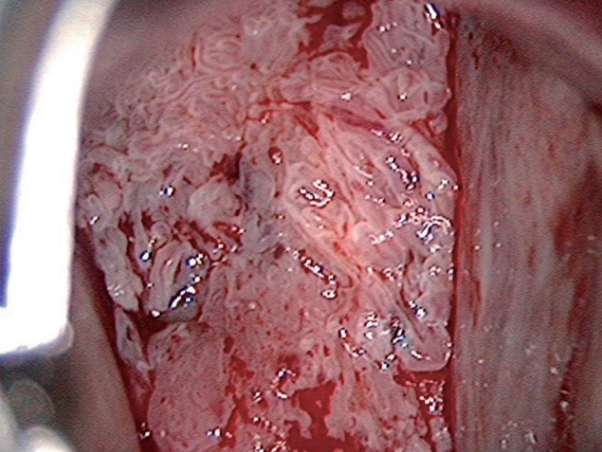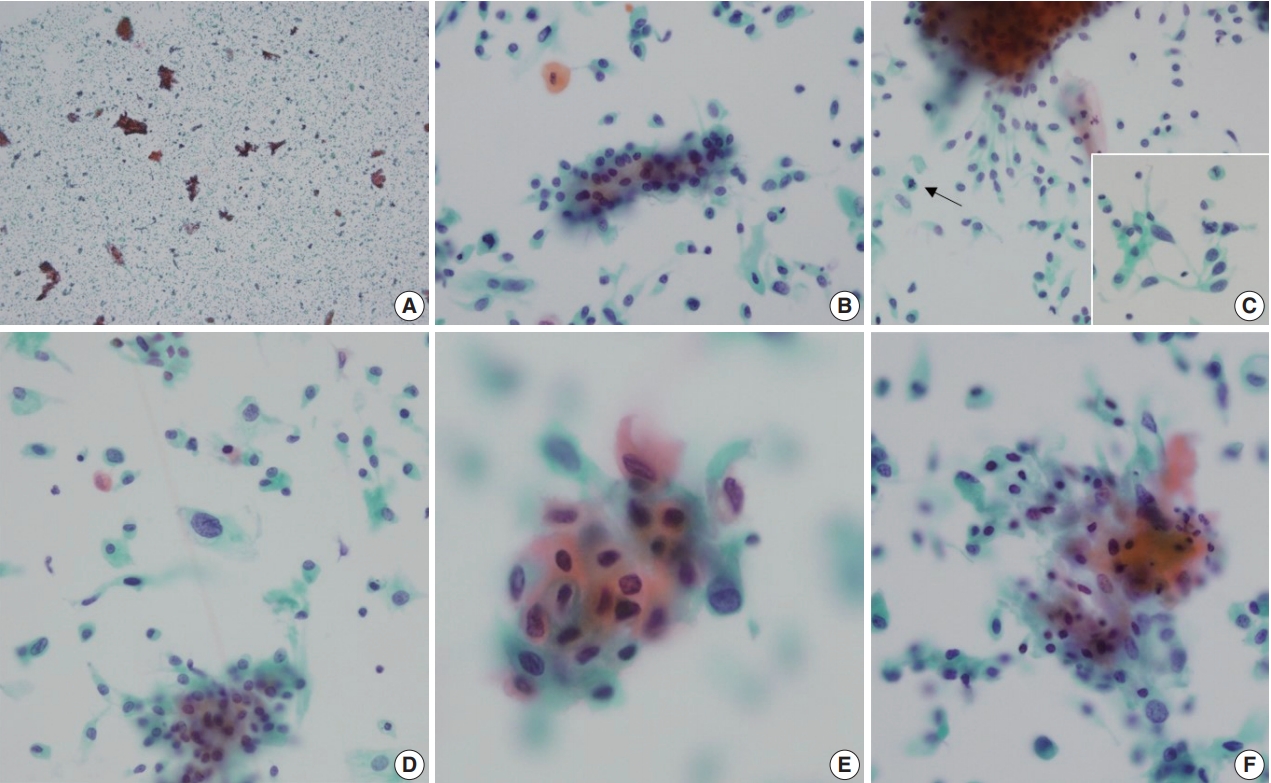Articles
- Page Path
- HOME > J Pathol Transl Med > Volume 53(5); 2019 > Article
-
Brief Case Report
Liquid-Based Cytology Features of Papillary Squamotransitional Cell Carcinoma of the Uterine Cervix -
Yangkyu Lee,*
 , Younghwa Choi,*
, Younghwa Choi,* , Kiryang Lee1
, Kiryang Lee1 , Youngeun Lee1
, Youngeun Lee1 , Hyojin Kim
, Hyojin Kim , Ji-Young Choe2
, Ji-Young Choe2 , Hye Seung Lee
, Hye Seung Lee , Yong Beom Kim3
, Yong Beom Kim3 , Haeryoung Kim,1
, Haeryoung Kim,1
-
Journal of Pathology and Translational Medicine 2019;53(5):341-344.
DOI: https://doi.org/10.4132/jptm.2019.06.05
Published online: June 24, 2019
Department of Pathology, Seoul National University Bundang Hospital, Seoul National University College of Medicine, Seongnam, Korea
1Department of Pathology, Seoul National University Hospital, Seoul National University College of Medicine, Seoul, Korea
2Department of Pathology, Hallym University Sacred Heart Hospital, Hallym University College of Medicine, Anyang, Korea
3Department of Obstetrics and Gynecology, Seoul National University Bundang Hospital, Seoul National University College of Medicine, Seongnam, Korea
- Corresponding Author: Haeryoung Kim, MD, PhD Department of Pathology, Seoul National University College of Medicine, Basic Science Building #101, 103 Daehak-ro, Jongno-gu, Seoul 03080, Korea Tel: +82-2-740-8322, Fax: +82-2-765-5600, E-mail: haeryoung.kim@snu.ac.kr
- *Yangkyu Lee and Younghwa Choi contributed equally to this work.
© 2019 The Korean Society of Pathologists/The Korean Society for Cytopathology
This is an Open Access article distributed under the terms of the Creative Commons Attribution Non-Commercial License (http://creativecommons.org/licenses/by-nc/4.0) which permits unrestricted non-commercial use, distribution, and reproduction in any medium, provided the original work is properly cited.
- A 77-year-old previously healthy woman presented with bloody vaginal discharge at the outpatient clinic. A colposcopy revealed a 2.5 cm-sized papillary mass (Fig. 1), and a punch biopsy was performed. After the possibility of a PSTCC or papillary SCC was suggested on the biopsy, she underwent a total abdominal hysterectomy with bilateral salpingo-oophorectomy. Two years later, she returned to the clinic complaining of vaginal discharge. A 6- mm-sized enhancing nodular lesion was noted at the right vaginal stump on pelvic computed tomography, and a cervicovaginal smear and punch biopsy was taken to confirm recurrence. However, further treatment of the vaginal lesion was not performed, as imaging incidentally revealed a pancreatic tail neoplasm with peritoneal seeding. The patient was subsequently referred to hospice care.
- At low-power magnification, the LBC preparation was highly cellular, showing a few small hyperchromatic crowded groups (HCGs) in a background of abundant scattered cells (Fig. 2A). At higher magnification, the HCGs were 3-dimensional irregularly-shaped papillary fragments containing fibrovascular cores. The atypical cells lining the papillary clusters were relatively uniformly distributed with mild nuclear overlapping (Fig. 2B). The nuclei were smaller than those of parabasal cells, and were round-to-oval with smooth nuclear membranes. Nucleoli were small and almost inconspicuous. Mitotic figures were only occasionally seen. Similar-looking atypical cells were individually scattered in the background (Fig. 2B, C). Some cells were spindled with long and tapered cytoplasmic processes (Fig. 2C). Altogether, most of the neoplastic cells demonstrated the cytological features of LGPUC. There were also a few interspersed cells with increased nuclear-to-cytoplasmic ratio, hyperchromasia and nuclear membrane irregularity, suggestive of high-grade squamous intraepithelial lesion (HSIL) (Fig. 2D). A small cluster of dyskeratotic cells was seen (Fig. 2E, F). Tumor diathesis was not identified.
- The biopsied tissue demonstrated papillary excrescences containing fibrovascular cores (Fig. 3A). The lining epithelium showed hybrid features of LGPUC and SCC (Fig. 3B, C). The LGPUClike component was seen towards the basal layers and showed mild cytological atypia. Towards the surface of the papillary stuctures, there was evidence of keratinization and high-grade cytologic atypia. Koilocytosis was focally seen (Fig. 3D). Although stromal invasion was not observed in the biopsied tissue, the subsequent hysterectomy specimen demonstrated residual tumor with stromal invasion and vascular invasion in the parametrial vessels. Immunohistochemistry revealed diffuse nuclear p63 expression, and the tumor cells were cytokeratin 7 (CK7)–positive and CK20-negative. A human papillomavirus (HPV) test (LG AdvanSure GenoBlot Assay, LG Life Sciences, Seoul, Korea) detected “other type” HPV. The histologic findings of the recurrent tumor were similar to that of the initial tumor.
- Ethics statement
- This case study was approved by the Institutional Review Board of Seoul National University Bundang Hospital (IRB approval number B-1710-427-702) and informed consent was waived.
CASE REPORT
- PSTCC was first reported in 1986 by Randall et al. [1] as a variant of SCC showing varying degrees of urothelial-like differentiation. Due to the predominantly exophytic nature of these tumors, invasion may not be detected on small biopsies or cervicovaginal cytology. However, despite the surface papillary growth pattern, PSTCCs have been frequently associated with deep invasion, local recurrence and distant metastasis [1-3].
- While the clinicopathological features of PSTCC have been discussed in several case reports, the cytological findings of PSTCC have only been described in two reports: one study described the LBC features of six cases [4], and the other one is a single case report describing the conventional smear features [5]. The LBC features of PSTCC in this case could be summarized as follows: (1) a moderate-to-high cellularity, (2) HCGs characterized by 3-dimensional papillary fragments with branching architecture, (3) urothelial-like features, and (4) loosely dispersed hyperchromatic parabasal-like cells in the background [4,5].
- The differential diagnosis of PSTCC includes a spectrum of lesions ranging from reactive to neoplastic, including papillary immature metaplasia and HSIL with papillary configuration [6,7]. Immature metaplastic and repair cells are immature parabasal-like cells with cytoplasmic projections, 2-dimensional sheets and fine chromatin, while PSTCCs frequently demonstrate 3-dimensional HCG with papillary architecture and hyperchromatic nuclei. Although papillary architecture may be seen in HSILs, the papillary fragments of PSTCC have been described to show more complex arborizing patterns [4]. In addition, the presence of horizontally aligned cells on the surface of papillary structures—similar to that seen in LGPUC in urine cytology—has been shown to be a characteristic cytological feature of PSTCC [4,8].
- Despite the urothelial-like features, PSTCCs have been suggested to be metaplastic variants of SCC. The CK7+/CK20–profile of PSTCC (including this case) is identical to that of müllerian epithelium [3]. Moreover, similarly to SCC, HPV and allelic losses at 3p have been implicated in the pathogenesis of PSTCCs, while chromosome 9 alterations (common in bladder cancer) were not detected [3,9,10].
DISCUSSION
Author contributions
Conceptualization: HK (Haeryoung Kim).
Data curation: YL (Yangkyu Lee), YC.
Investigation: YL (Yangkyu Lee), KL, YL (Youngeun Lee).
Methodology: YL (Yangkyu Lee), HK (Haeryoung Kim).
Resources: HK (Hyojin Kim), JYC, HSL, YBK, HK (Haeryoung Kim).
Supervision: HK (Haeryoung Kim).
Visualization: YL (Yangkyu Lee), HK (Haeryoung Kim).
Writing—original draft: YL (Yangkyu Lee), YC, KL.
Writing—review & editing: YL (Yangkyu Lee), KL, HK (Haeryoung Kim).
Conflicts of Interest
The authors declare that they have no potential conflicts of interest.
Funding
No funding to declare.


- 1. Randall ME, Andersen WA, Mills SE, Kim JA. Papillary squamous cell carcinoma of the uterine cervix: a clinicopathologic study of nine cases. Int J Gynecol Pathol 1986; 5: 1-10. PubMed
- 2. Al-Nafussi AI, Al-Yusif R. Papillary squamotransitional cell carcinoma of the uterine cervix: an advanced stage disease despite superficial location: report of two cases and review of the literature. Eur J Gynaecol Oncol 1998; 19: 455-7. PubMed
- 3. Koenig C, Turnicky RP, Kankam CF, Tavassoli FA. Papillary squamotransitional cell carcinoma of the cervix: a report of 32 cases. Am J Surg Pathol 1997; 21: 915-21. ArticlePubMed
- 4. Ng WK. Thin-layer (liquid-based) cytologic findings of papillary squamotransitional cell carcinoma of the cervix. Review of cases over a 4-year period with emphasis on potential diagnostic pitfalls. Acta Cytol 2003; 47: 141-8. PubMed
- 5. Vesoulis Z, Erhardt CA. Cytologic diagnosis of vaginal papillary squamotransitional cell carcinoma. A case report. Acta Cytol 2001; 45: 465-9. PubMed
- 6. Kokka F, Verma M, Singh N, Faruqi A, Yoon J, Reynolds K. Papillary squamotransitional cell carcinoma of the uterine cervix: report of three cases and review of the literature. Pathology 2006; 38: 584-6. ArticlePubMed
- 7. Kim HS, Seon MI, Kim YJ, Kim HS. Cytologic features of papillary immature metplasia of uterine cervix. Korean J Cytopathol 2002; 13: 21-7.
- 8. Chung YR, Won JK, Park IA, et al. Cytomorphological characteristics of low-grade papillary urothelial carcinoma for differential diagnosis from benign papillary urothelial lesions: logistic regression analysis in SurePath(TM) liquid-based voided urine cytology. Cytopathology 2016; 27: 83-90. ArticlePubMed
- 9. Fujimoto T, Sakuragi N, Shimizu M, et al. Papillary squamous cell carcinoma of the uterine cervix: a report of two cases with human papillomavirus 16 DNA. Acta Obstet Gynecol Scand 2002; 81: 176-8. ArticlePubMed
- 10. Maitra A, Gibbons D, Gazdar AF, Albores-Saavedra J. Allelic losses at chromosome 3p are seen in human papilloma virus 16 associated transitional cell carcinoma of the cervix. Gynecol Oncol 1999; 74: 361-8. ArticlePubMed
REFERENCES
Figure & Data
References
Citations

- Local and Metastatic Relapses in a Young Woman with Papillary Squamous Cell Carcinoma of the Uterine Cervix
Ha Young Woo, Hyun-Soo Kim
Diagnostics.2022; 12(3): 599. CrossRef
 PubReader
PubReader ePub Link
ePub Link-
 Cite this Article
Cite this Article
- Cite this Article
-
- Close
- Download Citation
- Close
- Figure




 E-submission
E-submission






